How and with what to treat tomatoes against late blight in a greenhouse: a review of the best remedies and effective folk methods
Late blight is secretly considered the worst enemy of tomatoes. And this is quite justified, because the disease occurs easily, but it is possible to cure plants only with the help of professional or proven folk methods.
Dangerous microbes can be anywhere: on seeds, in soil, in gardening tools. Fortunately, preventative measures can help prevent tomatoes from becoming infected. Let us further consider what late blight is and how to deal with it experienced summer residents are fighting.
Signs of late blight on tomatoes
Are sick late blight both varieties and hybrids. Even if all agrotechnical rules are followed, the disease can destroy most of the crop. Late blight is a fungal disease.
Plant infection occurs through fungal spores that penetrate the stem through the stomata. The causes of infection most often lie in improper care, high humidity, and sudden climate changes.
The fungus appears in the form of yellow and brown spots on leaves. You can also recognize the disease by dry leaves and wilting stems. If measures are not taken in time, then the tomatoes themselves begin to turn black and rot, brown ulcers appear on vegetables.
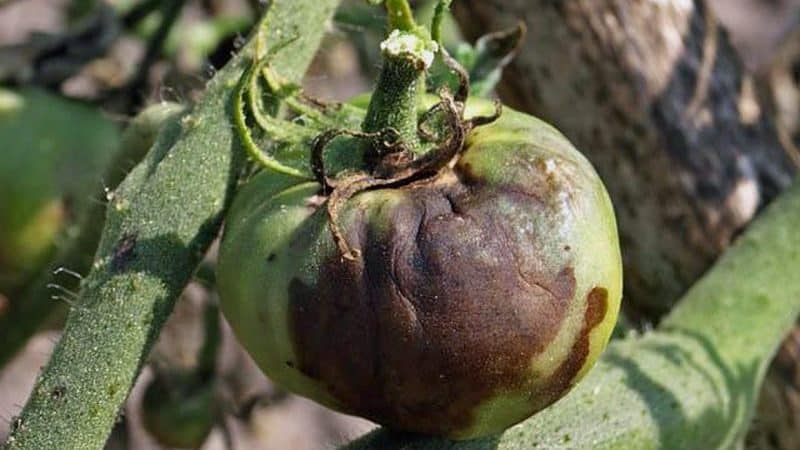
Important! Most often, signs of late blight are noticed in late July and early August. It is at this time that there is heat and high humidity. Dew and fog also help late blight develop faster. If measures are not taken, tomatoes will turn black within a day.
Rules for treating tomatoes against late blight in a greenhouse
Greenhouses and greenhouses have a special microclimate and high humidity, so summer residents are advised to use some tricks. They will help protect the crop from late blight and a number of other diseases:
- Cover the greenhouse with thick film. Drops of water accumulate on the roof at night and drip onto the plants during the day. Phytophthora spores can live in these very droplets. An improvised barrier prevents infection.
- In conditions of dense planting, the risk of developing the disease increases, therefore the distance between bushes should be at least 0.5 m.
- Ventilate the greenhouse regularly by opening the door or vents.. If this is not done, then constant high humidity will become the root cause of infection.
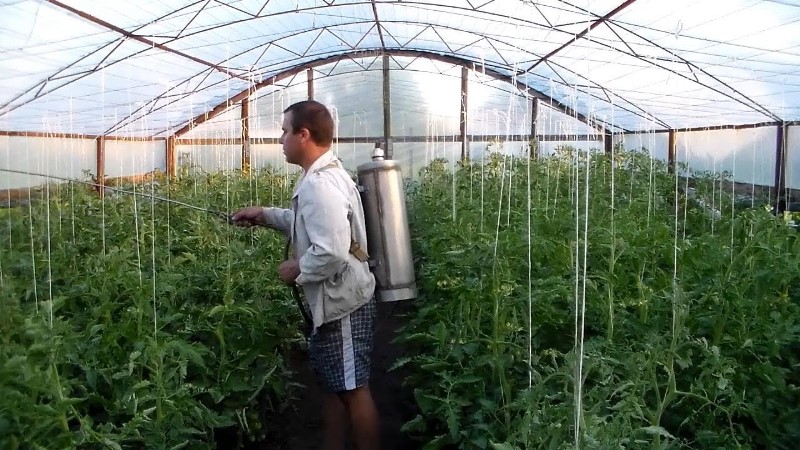
When and how to process
How to treat tomatoes against late blight in a greenhouse? “Oxyx” is recognized as an excellent remedy. The drug is sold in powder form and easily dissolves in water. The effectiveness of Oxychom does not depend on weather conditions. The medicine reduces the activity of pathogens and inhibits harmful cells.
Dissolve 20 g of powder in 10 liters of water, then spray the bushes with the resulting solution. Make sure that the drug gets more on the plant than on the ground. Carry out the procedure only with gloves and a respirator.
Profit Gold is also an effective remedy. The product is effective for two weeks. The drug is produced in the form of granules, which are dissolved in water in a ratio of 6 g per 10 liters of water. For the first time, Profit Gold is used immediately after signs of late blight are detected. In the future, summer residents recommend carrying out the procedure once every 3 weeks for preventive purposes.
Important! "Oxychom" and "Profit Gold" are fungicides, which are a group of chemical preparations for fungal diseases. To combat late blight in a greenhouse, it is recommended to use fungicides, since they are the most effective, especially when it comes to polycarbonate structures.
How to process tomatoes
All means of preventing and treating plants against late blight are divided into the following categories:
- Agrotechnical techniques, such as: removing weeds, burning garbage, disinfecting the land, etc. They create favorable development conditions for tomatoes. For example, land disinfection helps eliminate dangerous microorganisms in the soil and prevent infection. Weeds are also removed so as not to create conditions for the fungus to spread.
- Chemicals. This group represents the most powerful compounds, which are most often used in strict accordance with dosages and directions for use. Most chemicals are phytotoxic, so the beds need to be treated with them two weeks before the bushes bear fruit.
- Folk remedies. More affordable and easier to use drugs. Foliar spraying and treatment help combat late blight.
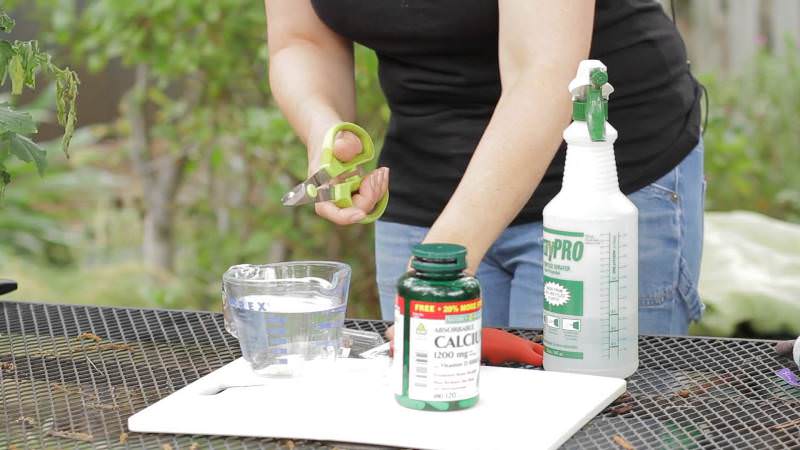
Purchased chemicals
Purchase chemicals in specialized stores for gardeners. They are most often sold in liquid, powder, or granule form. Such products are easy to use and fight the disease most effectively.
What means do most gardeners prefer? Let's consider the TOP 5 most effective, affordable and environmentally friendly drugs for combating tomato late blight:
- "Fitosporin M" - Available in powder, paste or liquid form.It is used at any stage of plant development. The effectiveness of Fitosporin M is from 65 to 95%.
- "Gamair" - Found in tablet or powder form. The drug is safe for both plants and humans. In addition to tomatoes, it is used to process grain crops, cucumbers and grapes.
- "Quadris" — in addition to protecting against disease, it improves the quality of the crop and increases its shelf life. Refers to fungicides.
- "Ridomil Gold" - widely used by gardeners throughout the country. It is most effective as a prophylactic agent, but also shows excellent results as a medicine. Reviews about it are extremely positive.
- "Thanos" - has a healing effect and is not washed off by watering and rain. Forms a protective film on the leaves that prevents spores from penetrating deeper.
Traditional methods
Plants with weak immunity are susceptible to any disease. Therefore, it is important to have with you in such a case improvised means, which at an early stage help prevent the development of late blight.
Hydrogen peroxide
The colorless liquid disinfects any damage to tomatoes and eliminates dangerous microbes that live in the soil. Also, due to the oxidative effect, peroxide improves the quality of water for spraying and irrigation.
As a preventative measure, moisten the soil with a peroxide solution at the rate of 3 liters of water per 60 ml of the product. If the disease has already appeared, then treat the stems and leaves with a peroxide solution at the rate of 1 liter of water per 2 tbsp. l. peroxide.
Copper sulfate
One of the advantages of copper sulfate is that it is not absorbed into the soil and tomatoes. The product is available and does not cause addiction in plants. The effect of the treatment lasts for two weeks.
To make the liquid you will need 50 g of granules and 5 liters of water.Treat tomato beds early in the morning or in the evening. If the weather forecast promises rain, it is better to postpone the procedure to another day.
Iodine
Another economical and effective method of preventing and controlling late blight. For 10 liters of water you will need 20 drops of iodine. In addition to treatment, the solution accelerates the development of bushes. It is recommended to treat the bushes with liquid every two weeks.
Experienced farmers also add 1 liter of skim milk to the solution. It forms a protective barrier on the leaves. The medicine can be used even during the ripening period of tomatoes.
Interesting. There is a legend about the invention of iodine. It appeared thanks to the French chemist Courtois Bernard in 1811. It is believed that the scientist’s cat is “to blame” for this: the pet jumped onto the table where there was an alcohol solution of seaweed ash and sulfuric acid. After accidentally mixing the liquids, iodine was obtained.
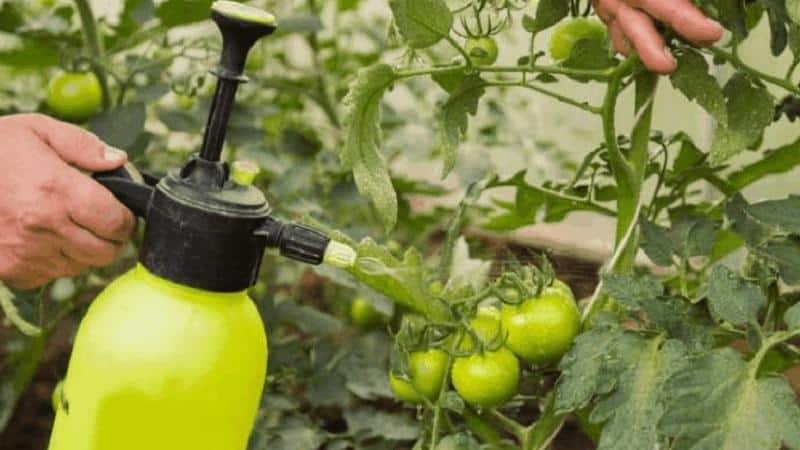
Kefir
To make the medicine you will need 1 liter of fermented kefir and 10 liters of water. In humid summer conditions, the bushes are sprayed every week. Also, instead of kefir, whey or milk is used. The product effectively fights fungus on both leaves and tomatoes.
Garlic and potassium permanganate
To prepare the product you will need 100 g of chopped garlic, 1 g of potassium permanganate and 10 liters of water. Spray the beds every 10 days. For 1 bush, 0.5 liters of solution is consumed.
Manganese is one of the most powerful drugs for disinfecting seeds, soil and bushes.
Wood tinder
Since ancient times, the mushroom has been famous for its beneficial properties. Take 100 g of dry crushed mushroom per 10 liters of boiling water. After the liquid has cooled, strain it. Use the product every 10 days.
Tips and tricks from experienced gardeners
To prevent the disease, the first treatment of tomato beds is carried out no later than 14 days from the date of planting. Then spraying is repeated every 10-15 days. Also, do not forget about loosening and weeding the beds. Do not plant tomatoes next to potatoes, as the risk of late blight infection increases.
Periodically sprinkle the beds with ash - it reduces the acidity of the soil and improves its nutritional properties. If the summer is hot and humid, reduce the number of waterings. If, on the contrary, the weather is dry, then moisten the beds more thoroughly. For the most competent distribution of liquid, use a drip irrigation system. Thanks to it, moisture comes directly to the root, bypassing the stem and leaves.
If you use fungicides, carefully read the information on the packaging and do not overdose. Most chemicals can only be used during the flowering period. For the best effect, it is recommended to alternate fungicides.
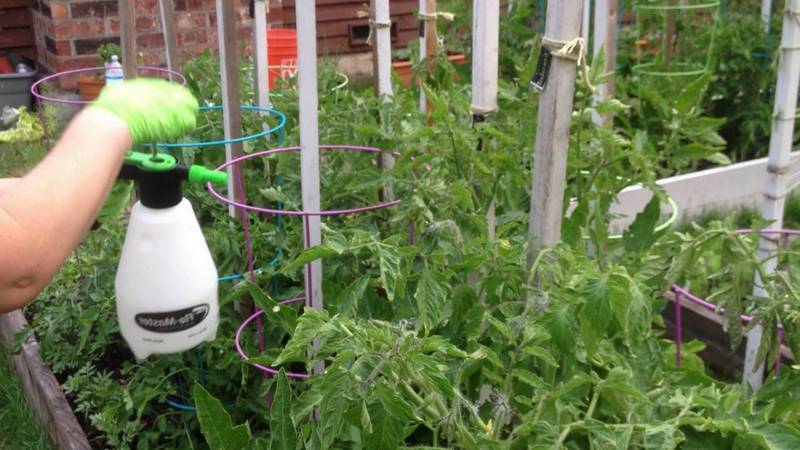
Important! Don't forget about feeding. Organic and mineral complexes increase the plant’s immunity, making it stronger and more resistant to late blight and other diseases. Nitrogen-containing substances, such as urea or ammonium nitrate, develop bushes especially well.
Conclusion
There is no such variety yet that would have 100% immunity to late blight. Even the best hybrids occasionally get sick. Therefore, it is important to have with you products that will quickly and effectively protect the beds from fungus.
Do not neglect prevention, because it helps to avoid many problems. If the plant does become ill with late blight, immediately spray with manganese, whey or iodine.Use fungicides to control progressive disease.